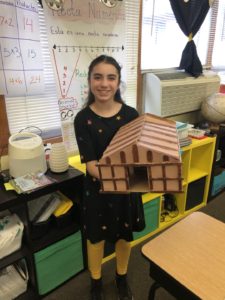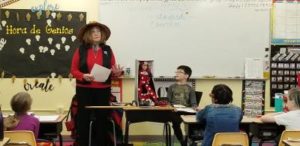La Lectura
We worked on conjugating verbs into the Vosotros and the Ustedes form. The vosotros is the 2nd person plural form of verbs but is very unfamiliar in our classrooms, as we all use the ustedes form instead of vosotros. The vosotros form is only used in Spain and Equatorial Guinea, in an informal way, and Ustedes in a formal way. In Latin America, people do not generally use the Vosotros form of the verb. We are teaching it so the students are aware of it’s existence. We do occasionally hear it in songs or books. The Ustedes form is the 3rd person plural and is also mostly used i
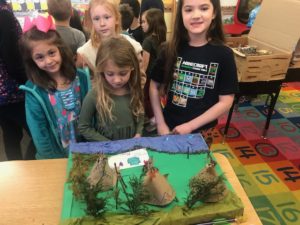
Sharing H&G projects with other classes.
n place of the 2nd person plural.
Students received their new spelling lists on Tuesday. They will have their next Spanish spelling test on Friday, March 6th.
We also worked on categorizing groups of words after finding similarities and differences. We did this using vocabulary from last week’s story: The Emperor who wore no clothes.
Las matemáticas
The kiddos did a great job with multiplication and division word problems this week. We really tried to visualize the story problems to help us truly understand which function we needed to use. I saw lots of light bulbs going on this week! Aha! Students took their end of unit test on Thursday and did a fantastic job!
Next week we will jumped right into our new Division chapter. What does this mean for our 2nd/3rd graders?
Big Idea: There can be remainders when dividing to make equal groups or when sharing equally.
- Use related multiplication facts to divide.
- Use patterns to divide multiples of 10 and 100.
- Divide a 1-digit number or a 2-digit number by a 1-digit number with or without remainder.
- Use different strategies to identify odd and even numbers.
- Use base-ten blocks and place value to divide 2-digit numbers without regrouping or remainders.
- Use base-ten blocks and place value to divide 2-digit numbers by a 1-digit number with regrouping, with or without remainders
- Thinking Skill:
- Identifying patterns and relationships
- Problem Solving Strategey:
- Use guess and check
- Key Visuals/Activities:
- Students use related multiplication facts to divide. They apply the inverse relationship of multiplication and division to write division statements from the corresponding multiplication sentence.
- Students learn that in division there is always a quotient and possibly a remainder.
- Students learn the steps of vertical division to divide with or without regrouping or a remainder.
Chapter Vocabulary:
- quotient- the answer in a division problem,
- remainder-the number leftover when a number cannot be evenly divided,
- even numbers- when an even number is divided by 2 there will not be a remainder,
- odd numbers-when an odd number is divided by there will be a remainder of 1.
History & Geography
I could not be more proud of the hard work these kids put into their reports, projects and presentations. Everyone did a fabulous job and we all learned new information about the selected tribes! Way to go kiddos!
Art with Ms. Kelly
Folk Art Flower Paintings:
Goals: Learn about self-taught African American artists Clementine Hunter and Horace Pippin
“Draw” with black paint – no pencil!
Use simple shapes similar to folk artists
Try different art media: tempera paint, watercolors, and chalk pastel
These beautiful, vivid flower paintings and drawings have been on the bulletin board at school. The students were so prolific that they had enough flower art to make beautiful Valentine cards!
Weaving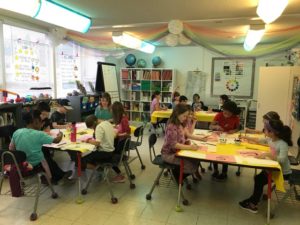
Learn weaving vocabulary: loom, warp threads, weft threads
Read A Goat in the Rug about a Navajo weaver
Create a small woven wall hanging
The students are doing a wonderful job on their weavings, and we plan to finish them next week.
Music with Ms. Nadia
Goodbye to February and Happy March! What better way to celebrate than on a bicycle built for two?
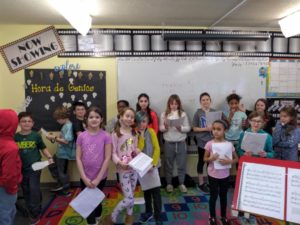 This past month has been an introduction to the choir! Not only are we learning the song A Bicycle Built for Two, the class is learning how to stand in choir formation, how to read sheet music, and fun ways to warm up our voices! Vocal warmups include One Bright and Sunny Morning, Bum-Biddily, 121, and sirens.
This past month has been an introduction to the choir! Not only are we learning the song A Bicycle Built for Two, the class is learning how to stand in choir formation, how to read sheet music, and fun ways to warm up our voices! Vocal warmups include One Bright and Sunny Morning, Bum-Biddily, 121, and sirens.
Students are also learning how to draw a treble clef and the names on of the notes on the staff. We turned the C Scale (C, D, E, F, G, A, B, c) into a secret code. The class took turns making words by writing notes on the staff, while everyone else had to guess the word. The process was then reversed, and students had to look at a word and figure out how to write the notes. Favorite words include “EGG”, “DAB”, and “GABE”. It’s a fun game to try at home!
Other highlights include weekly hangman, an Aaron Copland vs Tchaikovsky listening game, and Toystore.

